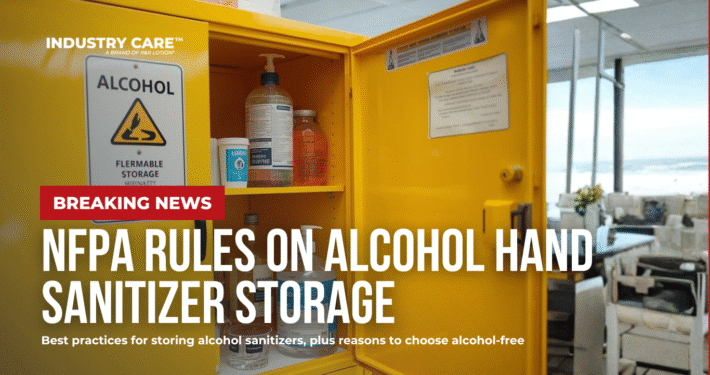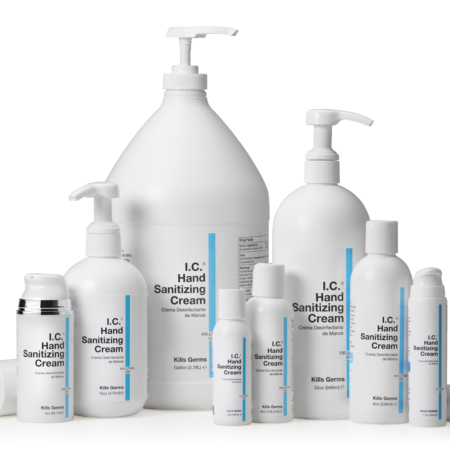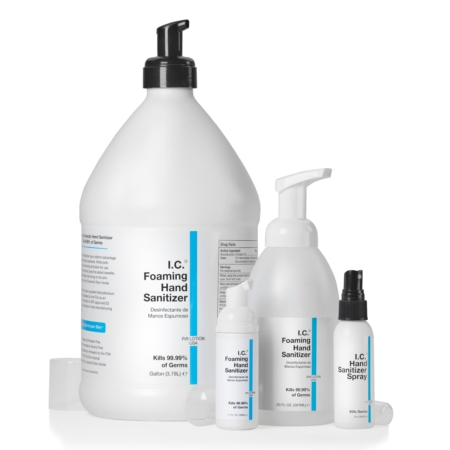NFPA Rules on Alcohol Hand Sanitizer Storage
The NFPA rules on alcohol hand sanitizer storage affect how facilities install, use, and store alcohol-based hand rubs (ABHRs). Because these products are flammable, there are limits on the total volume you can keep in use in a given area and requirements to store larger quantities in approved fireproof (flammable-liquid) cabinets or rooms. Below is a practical, plain-English guide to the key points—plus why many organizations are simplifying compliance by adopting alcohol-free options like R&R Lotion’s I.C. Sanitizing Cream and Foaming Hand Sanitizer.
Quick Summary
- In-use volume limits (outside cabinets): commonly 10 gallons per smoke compartment in non-sprinklered buildings; 20 gallons in sprinklered buildings.
- Bulk storage: larger quantities of ABHR should be in approved flammable-liquid storage cabinets or compliant storage rooms.
- Dispenser do’s: keep away from ignition sources, observe capacity limits per dispenser, and follow spacing rules.
- Compliance relief: alcohol-free products reduce fire-code burdens and simplify day-to-day hygiene.
Why Alcohol-Based Sanitizers Trigger Fire-Safety Rules
Most ABHRs contain 60–95% ethanol or isopropanol, which are classified as flammable liquids. As a result, codes address how much can be deployed across corridors, rooms, and “smoke compartments,” and how bulk supplies must be stored (e.g., in approved cabinets or specially constructed rooms).
NFPA Rules on Alcohol Hand Sanitizer Storage: Limits at a Glance
How to Stay Compliant with NFPA Rules on Alcohol Hand Sanitizer Storage
| Category | Common Requirement | What It Means for You |
|---|---|---|
| Aggregate “in-use” volume (outside cabinets) | Up to 10 gal per smoke compartment (non-sprinklered); up to 20 gal (sprinklered) | Count the liquid mounted in dispensers across the area; stay under your limit. |
| Bulk storage | Beyond small amounts, use compliant flammable-liquid storage cabinets or approved storage rooms | Store cases/jugs inside listed cabinets or a properly rated room. |
| Dispenser capacity | Individual dispenser size is limited based on location/building protection | Use appropriately sized units for corridors, rooms, and sprinkler status. |
| Placement | Keep clear of ignition sources; avoid mounting over carpet unless sprinklered | Don’t install above/next to switches, outlets, or open flames; follow local enforcement. |
| Spacing | Dispenser spacing and egress clearances apply | Maintain minimum distances and keep exit paths unobstructed. |
Note: Always verify with your Authority Having Jurisdiction (AHJ) which code edition and interpretations are enforced for your facility type.
Implications for Facilities & Compliance Tips
Given these rules, here are some practical implications and compliance tips:
-
Know your totals. If you’ve mounted multiple wall dispensers in a smoke compartment (corridor, suite, etc.), you must ensure the total ABHR volume (outside storage cabinets) doesn’t exceed the aggregate limit (10 gal or 20 gal depending on sprinkler system).
-
Separate dispensers properly. Dispensers must be at least 48 in (1.22 m) apart horizontally from each other. APIC+1
-
Avoid installation near ignition sources. Keep dispensers away from open flames, electrical receptacles, switches, etc. UW Environmental Health & Safety+1
-
Beware of carpet overrun areas. If you place a dispenser over carpet, ensure the building is sprinklered—or else you may violate code. NFPA Doc Info Files+1
-
Bulk storage triggers stronger rules. If you keep more than 5 gal in a supply closet (or sizable amounts in pallet racks), you may need an NFPA 30-compliant room or cabinet (fire-resistive construction, automatic sprinklers, etc.). Healthcare Facilities Today+1
-
Evaluate your storage cabinet. If you choose to use a flammable-liquid storage cabinet, this may permit greater quantities—but the cabinet must meet code (venting, labeling, clearance, etc.) and may require additional fire-suppression or room rating per NFPA 30. National Fire Sprinkler Association+1
-
Check local adoption and inspect. Many of these rules are adopted by local fire marshals and AHJs (Authorities Having Jurisdiction). Always check with your local jurisdiction to confirm what edition of the code is enforced and how strictly.
-
Training & signage. Make sure staff are aware of the code constraints and that storage areas are clearly labeled. Also keep records of where dispensers are mounted and what their capacity is, in case of inspection.
How to Stay Compliant (Checklist)
- Inventory all mounted dispensers and total fluid per smoke compartment.
- Select dispenser sizes appropriate to corridors vs. rooms and sprinkler status.
- Maintain safe distances from ignition sources; avoid over-carpet installs unless allowed.
- Store cases and refills in approved flammable-liquid storage cabinets or compliant rooms.
- Document locations, capacities, and cabinet specs for inspections.
- Review changes with your AHJ; train staff and label storage areas clearly.
A Simpler Path: Alcohol-Free Sanitizing Options
With all of these rules and potential compliance headaches around alcohol-based hand-sanitizers, many facilities are turning toward alcohol-free sanitizing options, which offer several key benefits:
Benefits of Alcohol-Free Products
-
Minimal fire-safety burden. Because they don’t contain high percentages of alcohol, they are not typically classified as flammable liquids under the same codes—or at least they fall outside that regulatory regime. This means fewer restrictions on volume, placement, and storage.
-
Simplified installation and use. No special spacing, cabinet requirements, or large-volume storage rooms to design around. You can mount dispensers or provide creams more freely.
-
Gentler on skin & surfaces. Many alcohol-free formulas include moisturizing or cream-based agents which can be less drying—leading to improved user comfort and compliance.
-
Versatility. Hand-sanitizing creams or foam that are alcohol-free can be placed in more varied settings (offices, schools, elevators, shared equipment) where fire-code concerns might otherwise limit ABHR placement.
-
Peace of mind. Having an alcohol-free option can ease the regulatory burden and lower risk of code violations or fire-hazard incidents tied to sanitizer storage and dispenser placement.
How This Relates to Our Products
At [Your Company Name], we offer a pair of ready-to-deploy alcohol-free solutions that align perfectly with the simplicity and safety advantages just described:
-
I.C. Sanitizing Cream: A non-alcohol cream-based sanitizer ideal for high-touch areas and places where traditional hand rubs might not be allowed or practical. Because it’s alcohol-free, you avoid the bulk-storage, cabinet, and volume-limits associated with ABHRs.
-
I.C. Foaming Hand Sanitizer (Alcohol-Free): A convenient foaming formulation with no alcohol, designed for quick deployment in corridors, waiting rooms, offices, and other high-traffic locations. Since it lacks the typical 60 %+ alcohol content, you get the hygiene benefit without triggering the stringent flammability-based code requirements.
By incorporating these alcohol-free options into your hygiene program, you not only stay compliant with the latest NFPA / fire-safety rules but also make your facility’s hand-hygiene strategy easier to manage and document.
Ready to simplify NFPA compliance?
Swap high-maintenance ABHR storage for alcohol-free peace of mind. Ask our team for a quick compliance review and product recommendations tailored to your facility.
This article summarizes common NFPA-aligned practices for ABHRs. Always consult your local fire marshal/AHJ for the exact edition and requirements applicable to your facility.









